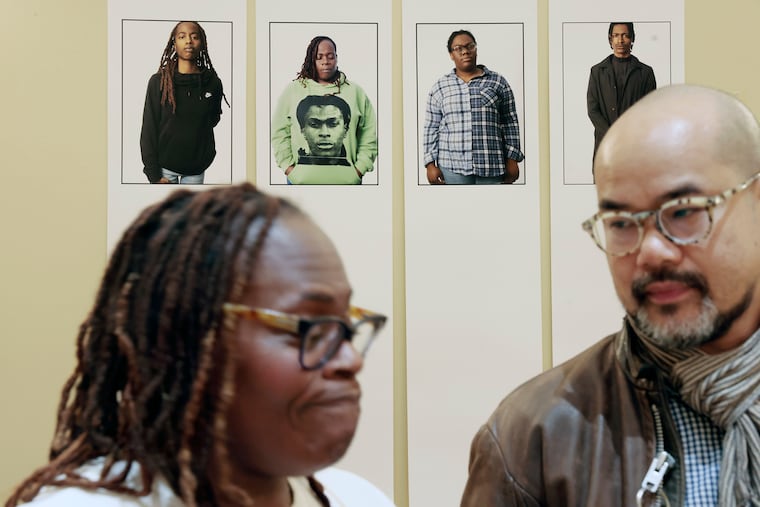A portrait project for victims of gun violence shows trauma knows no bounds
An ever-expanding memorial underscores the universal language of grief.

Howard Henry Chen had just turned 3 when he and his family boarded one of the last planes out of Vietnam in 1975, just before the fall of Saigon that effectively ended the Vietnam War.
Katrina Crump’s 19-year-old son Kamaj Juanir Rudd was fatally shot in West Kensington on Sept. 14, 2021; one of more than 500 shooting deaths in Philadelphia during a year that ended with a record number of homicides.
Their stories are separated by oceans and decades, but shared trauma has a way of closing even the widest gaps.
Crump and Chen came together after I put out a call last year for artists to step up for the Souls Shot Portrait Project, which memorializes victims of gun violence.
Chen, a multidisciplinary artist, met Crump at her home, and after hearing her story, almost immediately recognized their common bond.
“I’m a former war refugee,” said Chen, who grew up in Camp Hill, a suburb of Harrisburg about a half hour away from the resettlement camp in Fort Indiantown Gap, where his family was placed when they arrived in the States. “I didn’t experience gun violence, but I grew up hearing stories in my family of trauma and violence.”
Crump said she was thrilled when she was paired with one of the project’s artists but was surprised when Chen traveled to her home in Frankford multiple times for long talks with her and her family, including a conversation at her son’s grave at Mount Peace Cemetery.
“I thought someone would call me, maybe ask a few questions and for a few pictures, but he really put in a lot of time.”
She appreciated most the care Chen took with her son’s memory, a young man she described as “a big jokester.”
“He loved life.”
The portrait project started in 2016, when the leaders of the Presbyterian Church of Chestnut Hill asked Laura Madeleine, the project’s executive director, to curate an exhibition for Heeding God’s Call to End Gun Violence, a faith-based anti-violence campaign.
The exhibit was supposed to be up for about a month, but six years later it has expanded, with volunteer artists creating well over 100 portraits. That number represents a fraction of the people affected by gun violence, but organizers say displaying about 30 portraits at a time makes it easier to find spaces to host the exhibit, including libraries, hospitals, and churches.
In 2021, organizers of the exhibit issued a series of increasingly urgent pleas on social media asking portrait photographers to lend their talents to the project. I had been slow to realize what was behind their insistence until it hit me: There were more gun violence victims in our city than there were artists volunteering to memorialize them.
It was a sad commentary on the state of Philadelphia, and another milepost of our city’s soaring gun violence epidemic. Two months after her son’s death, Crump and her family returned to the site where he was shot for a vigil when they were targeted by bullets coming from a passing car. No one was killed, but several family members, including Crump, sustained serious injuries. She still has a bullet lodged in her right thigh.
I was glad to hear that about a dozen artists — many of whom have their own experiences with violence — came forward to help honor those who’ve been lost.
Chen, who in early November joined Crump at the Presbyterian Church of Chestnut Hill for the exhibit’s opening ceremony, said he felt a sense of responsibility to contribute to the effort.
“It’s humbling to meet someone whose loss was so profound, so near, and so recent, and for them to open up about it,” he said.
Over several visits with the family this past spring, Chen created five photographs of Crump’s family members and her son’s childhood friend to represent the ripple effects of trauma. Four of the photos will hang inside the church until December, when the exhibit begins traveling to other locations.
In one of the most striking portraits, Crump, pictured in a green sweatshirt with her son’s photo imprinted on the front, has her eyes closed.
Standing next to the portrait, she recalled what she was feeling when it was taken: “Hurt, anger, disbelief, shock, numbness …”
But when people see it, she said, what she hopes they see is “a mother searching for the strength to go on.”
“Day by day, hour by hour, second by second.”
Fourteen months after her son’s death, that search continued inside the Chestnut Hill church.
When Crump walked inside, she was initially overwhelmed, overcome with emotion. But as she took in all of the portraits, and the crowd gathered to honor those who died and those left behind, she found fellowship in the collective loss, the universal language of trauma.
I wish it wasn’t so, but the Souls Shot Portrait Project is always looking for more artists and volunteers to help grieving families honor their lost loved ones.
So consider this a standing ask, and reach out to Madeleine at soulsshotportraitproject@gmail.com if you can help with the project — a reminder of the connective power of grief, and an indictment of our city’s ongoing shame.